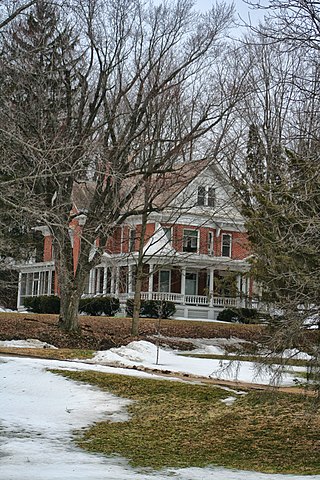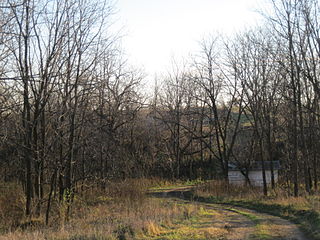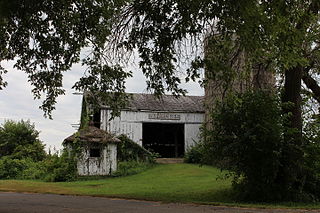
The John Scott Farm is a historic farmstead near the community of Shandon, Ohio, United States. Established in the nineteenth century and still in operation in the twenty-first, the farmstead has been named a historic site because of its traditionally built agricultural structures.

The Thorstein Veblen Farmstead is a National Historic Landmark near Nerstrand in rural Rice County, Minnesota, United States. The property is nationally significant as the childhood home of Thorstein B. Veblen (1857-1929), an economist, social scientist, and critic of American culture probably best known for The Theory of the Leisure Class, published in 1899.

The Bonde Farmhouse is a historic farmhouse located in Wheeling Township in Rice County, Minnesota, United States, approximately 1 mile (1.6 km) from Nerstrand. The private home was placed on the National Register of Historic Places (NRHP) on April 6, 1982. The farmhouse is significant both for its association with a prominent Norwegian immigrant family as well as its local limestone construction and outstanding integrity.

The Freitag Homestead is a historic farm begun in 1848 in the town of Washington, Green County, Wisconsin. It is also the site of the first Swiss cheese factory in Wisconsin. The farm was added to the National Register of Historic Places in 2005.

The Jacob Voigt House is a historic farm located in Mequon, Wisconsin, United States. It was added to the National Register of Historic Places in 2000.

The Nelson Farm is a historic farmstead in rural Merrick County, in the east central part of the state of Nebraska in the Midwestern United States. Originally settled by Swedish immigrants in 1879, it was expanded and improved over the subsequent eighty years and more, remaining in the founder's family into the fourth and fifth generations.
The John and Katharine Tunkun Podjun Farm is a farm located at 9581 East 1 Mile Road in Ellsworth, Michigan. It was listed on the National Register of Historic Places in 2002.
The Donovan–Hussey Farms Historic District encompasses a pair of 19th-century farm properties in rural Houlton, Maine. Both farms, whose complexes stand roughy opposite each other on Ludlow Road northwest of the town center, were established in the mid-19th century, and substantially modernized in the early 20th century. As examples of the changing agricultural trends of Aroostook County, they were listed on the National Register of Historic Places in 2009.

The David Hanaford Farmstead is a historic farm in Monticello Township, Minnesota, United States. It was first settled in 1855 and features a farmhouse built in 1870 and a barn from around the same time. The farmstead was listed on the National Register of Historic Places in 1979 for having local significance in the themes of agriculture and exploration/settlement. It was nominated for being "an excellent example of an early Wright County farmstead developed by a pioneer family from New England."

The King Farm is a historic farm property at King Farm Road in Woodstock, Vermont. Encompassing more than 150 acres (61 ha) of woodlands and pasture, the farm has 150 years of architectural history, include a rare 18th-century English barn. Originally a subsistence farm, it became a gentleman's farm in the late 19th century, and its farmstead now hosts a regional government commission. The farm was listed on the National Register of Historic Places in 1997.

The John and Marie (Palen) Schrup Farmstead Historic District is a nationally recognized historic district in Dubuque County, Iowa, United States. It was listed on the National Register of Historic Places in 2009. At the time of its nomination it consisted of four resources, which included three contributing buildings and one non-contributing building. The three buildings include a stone house, barn, and well-house. The buildings are typical of those constructed by immigrant families from Luxembourg that settled in Dubuque and nearby Jackson counties. The front part of the house is the oldest structure here and was built when Martin Burkhart owned the property. He sold the farmstead to Casper Burkhart the following year, who then sold it to John and Marie Schrup in 1856. The Schrups were responsible for adding onto the back of the house about the time they bought it and the other two buildings. The dairy farm of 193 acres (78 ha) remained in the family until 1973. Because it was always a modest enterprise, the stone buildings were not torn down and replaced with modern structures as happened on many of the Luxembourgian farms built in the mid-19th century. A wooden shed was built in the early 20th century, and is the non-contributing building. A pole barn was also added to the farmstead and it fell down c. 1995.
The Osage Farms Resettlement Properties in Pettis County, Missouri is a National Register of Historic Places multiple property submission located at Pettis County, Missouri. The submission includes 10 national historic districts and 2 individual properties listed on the National Register of Historic Places. The properties included were built by the Resettlement Administration / Farm Security Administration in 1937 as model farms and known as Osage Farms. Model farmsteads typically included a 1+1⁄2-story frame dwelling, barn, poultry house and privy.

The Mottley Family Farmstead on Ivey Road in Willow Springs in Lafayette County, Wisconsin is a 8 acres (3.2 ha) property which was listed on the National Register of Historic Places in 2001. The listing included three contributing buildings.

The Bedrud–Olson Farmstead is a highly intact tobacco and dairy farm with surviving buildings built between 1856 and 1915 in Christiana, Dane County, Wisconsin. It was added to the State and the National Register of Historic Places in 1999.

The Erastus Dean Farmstead in Bradford, Wisconsin is probably the oldest complex of farm buildings in Rock County, with the house built in 1840 and the barn in 1844. The farm was listed on the National Register of Historic Places in 1978 and on the State Register of Historic Places in 1989.

The John Sweet Donald Farmstead is a historic farm in Springdale, Wisconsin with surviving structures built as early as 1858. It is significant as the home and testing grounds of John Sweet Donald, a farmer, statesman, and educator of the Progressive Era.

The Adam Dunlap Farmstead, built by a Yankee settler family, was one of the first farms in the Town of Mazomanie, Wisconsin. A number of the original structures, built around 1849 from stone quarried on the farm, are still intact. The farmstead was added to the State and the National Register of Historic Places in 2003, for being a relatively intact homestead of a progressive Yankee pioneer settler, and for the Greek Revival style of the stone farmhouse.

The Frederick Schumann Farmstead is a well-preserved saltbox-shaped stone farmhouse built by a German immigrant family in 1878 in Berry, Wisconsin. In 1993 it was listed on the National Register of Historic Places.

The Eric and Jerome Skindrud Farm is a farm started by Norwegian immigrants in Springdale, Wisconsin with intact farm buildings as old as 1876. The farm lies in a big valley prone to erosion and was early to try out erosion control dams and planting crops in contour strips. In 1994 the farm was added to the State and the National Register of Historic Places.

The Michael and Margaritha Beck Farmstead is located in Jefferson, Wisconsin.

















